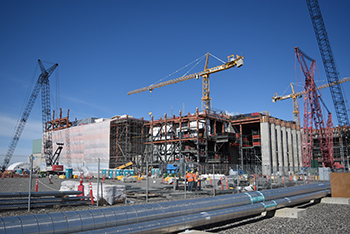High-Level Waste (HLW) Facility
 The High-Level Waste (HLW) Facility will be used to vitrify the high-level waste received from the Tank Farms, where the waste is stored. After vitrification, the waste will be in a stable and solid form.
The High-Level Waste (HLW) Facility will be used to vitrify the high-level waste received from the Tank Farms, where the waste is stored. After vitrification, the waste will be in a stable and solid form.
In the HLW Facility, high-level waste will be mixed with glass-forming materials in two 90-ton melters and heated to 2,100 degrees Fahrenheit.
The mixture will then be poured into stainless steel canisters that are approximately 2 feet in diameter, 14.5 feet tall and weigh more than 4 tons. When fully operational, the HLW Facility will produce an annual average of 480 canisters.
When complete, the HLW Facility will be 440 feet long and 275 feet wide, approximately the size of three football fields, and 95 feet, or six stories, high. Once filled, the high-level waste canisters will be transported and temporarily stored in Hanford’s 200 Area until a national repository is established. When fully operational, the HLW Facility will product approximately 1,100 canisters annually.
Both engineering and construction work continue on the High-Level Waste Facility, as DOE and Bechtel National, Inc., remain committed to completing the mission.
A Closer Look
The Melter Caves
The HLW Facility will contain two identical melter caves that hold the 90-ton melters. Due to high levels of radioactivity in the caves, all operations and maintenance activities will be performed using remotely operated overhead cranes and manipulators. Each cave will contain a series of complex utilities to support the melters, including offgas cleaning systems that include a submerged bed scrubber vessel and two high-efficiency mist eliminators.




